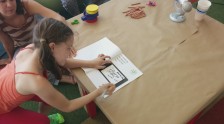Reframing the Conversation: Gender, Design and the Working Mom
Kamdyn Moore, Senior Project Manager, examines a powerful new story on maternity leave in the New Republic and what it means to the Femme Den.
The topic of working mothers is not a new one, but the conversation has shifted dramatically in recent years. Today, talk of “leaning in” and “having it all” has created greater awareness for campaigns like #ChangeTheRatio and #LeadOnLeave and has led to a slew of articles and debates in the media. Even my family has been part of the dialogue: for the last year, we have participated in photojournalist Alice Proujansky’s ongoing project entitled “Working Mothers,” which documents the ways women integrate their identities as workers and mothers. Her work was recently featured in an incredible article on maternity leave written by Rebecca Traister of the New Republic.
At its heart, Traister’s article is about organizational change as it relates to women in the workplace. She strikes a solid balance between personal and policy and addresses the shifts that must occur within organizations to break down the barriers that are preventing women, especially working mothers, from achieving the equality and opportunities they deserve. The article resonated with me on two levels: first because I, too, am a working mother and second because it so astutely challenges many of the obstacles and issues we tackle on behalf of people and organizations every day in the Femme Den.
Our work in Femme Den has always focused on finding better ways to understand and connect with women’s subtle (and not-so-subtle) needs and desires, and then designing for those needs. We are working to counteract what we see on the surface as shortsightedness on the part of companies developing “feminized” products and services for this key consumer group, as a way of addressing the more fundamental issue: that too many organizational cultures simply do not understand the impact of design for women and the potential benefit for their brand.
But beyond the output – the shiny objects, the clothes, the gadgets – we’re also working to surface more of the intangible, blurrier aspects of design and gender that too many companies overlook. And today, that blurrier part of design is about social impact.
It’s about designing organizations that are better for their employees, facilitating better relationships between people, and about making sense of technologies, behavior patterns and delivery systems in a meaningful way. So, at the Femme Den, we’re asking some important questions these days – mainly, how can we reframe the conversation about design and gender that gets to the heart of, and presents solutions for, some of Traister’s arguments?
As we work to answer these questions both internally and with our clients, we challenge you to do the same.
Photo credit: Alice Proujansky from her “Working Mothers” series and The New Republic.





